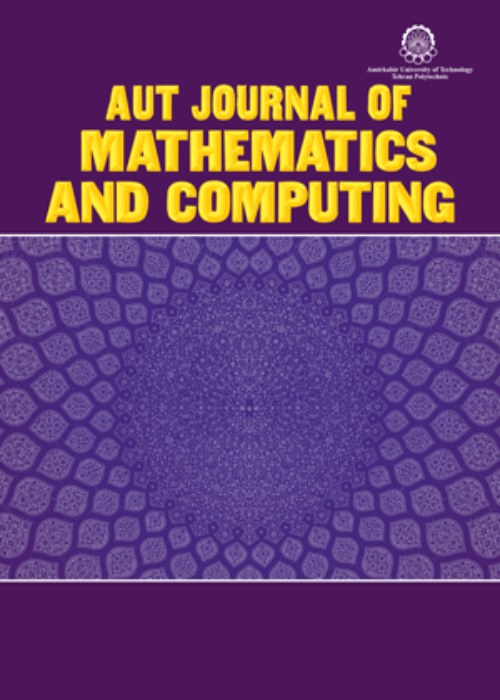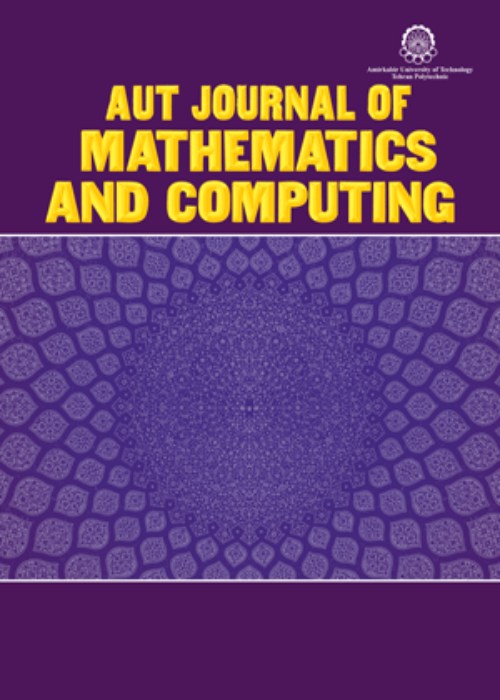فهرست مطالب

AUT Journal of Mathematics and Computing
Volume:4 Issue: 1, Feb 2023
- تاریخ انتشار: 1401/11/12
- تعداد عناوین: 12
-
-
Pages 1-15
We collect together some known results concerning the codes from adjacency matrices of the graph with vertices the nodes of the m-ary n-cube $Q^m_n$ and with adjacency defined by the Lee metric, and include some new results.
Keywords: $n$-cubes, graphs, codes, permutation decoding -
Pages 17-26This paper is dealing with a split extension group of the form 26:(3 x A5), which is the largest maximal subgroup of the Symplectic group Sp(4,4). We refer to this extension by bar{G} . We firstly determine the conjugacy classes of bar{G} using the coset analysis technique. The structures of inertia factor groups were determined. We then compute the Fischer matrices of bar{G} and apply the Clifford-Fischer theory to calculate the ordinary character table of this group. The Fischer matrices of bar{G} are all integer valued, with sizes ranging from 1 to 4. The full character table of bar{G} is 26 x 26 complex valued matrix and is given at the end of this paper.Keywords: Group extensions, Symplectic group, inertia groups, Fischer matrices, character table
-
Pages 27-37A finite group G is said to be (l,m, n)-generated, if it is a quotient group of the triangle group T(l,m, n) = ⟨x, y, z| x l =y m = z n= xyz = 1⟩. In [J. Moori, (p, q, r)-generations for the Janko groups J1 and J2, Nova J. Algebra and Geometry, 2 (1993), no. 3, 277-285], Moori posed the question of finding all the (p,q,r) triples, where p, q and r are prime numbers, such that a non-abelian finite simple group G is (p,q,r)-generated. Also for a finite simple group G and a conjugacy class X of G, the rank of X in G is defined to be the minimal number of elements of X generating G. In this paper we investigate these two generational problems for the group PSL(3,7), where we will determine the (p,q,r)-generations and the ranks of the classes of PSL(3,7). We approach these kind of generations using the structure constant method. GAP [The GAP Group, GAP-Groups, Algorithms, and Programming, Version 4.9.3; 2018. (http://www.gap-system.org)] is used in our computations.Keywords: conjugacy classes, (p, q, r)-Generation, rank, structure constant
-
Pages 39-46For a 1-(ν,κ,λ) design $\mathcal{D}$ containing a point $x$, we study the set $I_x$, the intersection of all blocks of $\mathcal{D}$ containing $x$. We use the set $I_x$ together with the Key-Moori Method 2 to construct reduced designs invariant under some families of finite simple groups. We also show that there is a connection between reduced designs constructed by Method 2 and the new Moori Method 3.Keywords: Reduced design, Key-Moori Method 2, Method 3, simple groups
-
Pages 47-55In this paper, using a method of construction of 1-designs which are not necessarily symmetric, introduced by Key and Moori, we determine a number of 1-designs with interesting parameters from the maximal subgroups and the conjugacy classes of the group PSL(2,q) for q a power of an odd prime.Keywords: Linear group, Design, conjugacy class, maximal subgroup, primitive permutation representation
-
Pages 57-61The Frobenius group was defined more than 120 years ago and has been the center of interest for researchers in the field of group theory. This group has two parts, complement and kernel. Proving that the kernel is a normal subgroup has been a challenging problem and several attempts have been done to prove it. In this paper we prove some character theory properties of finite Frobenius groups and also give proofs of normality of the kernel in special cases.Keywords: Frobenius group, Frobenius complement, Frobenius kernel, character, Permutation character
-
Pages 63-67In the recent paper [A generalization of Taketa's theorem on M-groups, Quaestiones Mathematicae, (2022), https://doi.org/10.2989/16073606.2022.2081632], we give an upper bound 5/2 for the average of non-monomial character degrees of a finite group G, denoted by acdnm(G), which guarantees the solvability of G. Although the result is true, the example we gave to show that the bound is sharp turns out to be incorrect. In this paper we find a new bound and we give an example to show that this new bound is sharp. Indeed, we prove the solvability of G, by assuming acdnm(G)<acdnm(SL2(5))=19/7.Keywords: Monomial character, Primitive character, Taketa’ s Theorem, Average degree
-
Pages 69-78In this paper, under certain conditions, we show that the non-abelian CP exterior product distributes over direct product of Lie algebras. Then we present some properties about CP extension of Lie algebras.Keywords: CP exterior product, $, tilde{B, 0}$-pairing, Curly exterior product, Bogomolov multiplier, CP extension, CP cover
-
Pages 79-85Diaconis and Isaacs defined the supercharacter theory for finite groups as a natural generalization of the classical ordinary character theory of finite groups. Supercharacter theory of many finite groups such as the cyclic groups, the Frobenius groups, etc. were well studied and well-known. In this paper we find the normal and automorphic supercharacter theories of the dihedral groups in special cases.Keywords: Dihedral group, supercharacter, superclass, Lattice of normal subgroups
-
Pages 87-89For a character χ of a finite group G, the number $χc (1)=\frac{[G:ker χ]}{χ(1)} $ is called the co-degree of χ. Let Sol(G) denote the solvable radical of G. In this paper, we show that if G is a finite non-solvable group with {χc(1)2 : χ∈Irr(G)={1,2m} for some positive integer m, then G/Sol(G) has a normal subgroup M/Sol(G) such that M/Sol(G) ≅ PSL2(2n) for some integer n≥2, [G:M] is odd and $G/Sol(G) \lesssim Aut(PSL2(2n)$.Keywords: The co-degree of a character, non-solvable groups, irreducible character degrees
-
Pages 91-97Let G be a finite group and cd(G) be the set of irreducible complex character degrees of G. It was proved that some finite simple groups are uniquely determined by their orders and their degree graphs. Recently, in [Behravesh, et al., Recognition of Janko groups and some simple K4-groups by the order and one irreducible character degree or character degree graph, Int. J. Group Theory, DOI: 10.22108/ijgt.2019.113029.1502.] new characterizations for some finite simple groups are given. Also, in [Qin, et al., Mathieu groups, and its degree prime-power graphs, Comm. Algebra, 2019] the degree prime-power graph of a finite group is introduced and it is proved that the Mathieu groups are uniquely determined by order and degree prime-power graph. In this paper, we continue this work and we characterize some simple groups and some characteristically simple groups by their orders and some vertices of their degree prime-power graphs.Keywords: Nonsolvable group, prime-power graph
-
Pages 99-103Let G be a Frobenius group. Using Character theory, it is proved that the Frobenius kernel of G is a normal subgroup of G, which is well-known as the Frobenius Theorem. There is no known character-free proof for this Theorem. In our note, we prove it by assuming that Frobenius groups are non-simple. Also, we prove that whether K is a subgroup of G or not, Sylow 2-subgroups of G is either cyclic or generalized quaternion group. In addition, by assuming some extra arithmetical hypotheses on G, we prove the Frobenius Theorem. We should mention that our proof is character-free.Keywords: Finite group, Frobenius group, Frobenius Theorem


